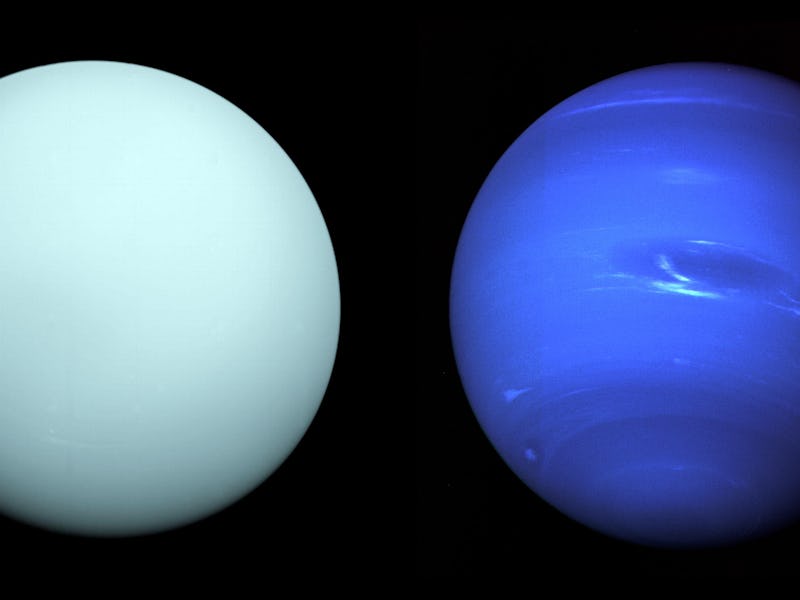A recent NASA-sponsored study about potential missions has posed some big questions about studies of our solar system’s “ice giants,” namely: how we’d get to Uranus and Neptune, and what do we study when do?
The two have only been visited once by the Voyager 2 spacecraft. In these close flybys in the late 1980s (Uranus was 1986 and Neptune was 1989) we got a quick glimpse of their composition and a few hazy images. But, for the most part, they are still utter mysteries to astronomers.
“We do not know how these planets formed and why they and their moons look the way they do,” Amy Simon of NASA’s Goddard Space Flight Center, said. “There are fundamental clues as to how our solar system formed and evolved that can only be found by a detailed study of one, or preferably both, of these planets.”
Uranus on the right is shrouded in a haze while Neptune, on the left, is seen brightly, with the Great Dark Spot taking center stage.
NASA is laying the groundwork for a series of orbiters, probes, and even rovers that would fly through the atmospheres of the planets and collect data about the chemical makeup. These ice giants, while not too different from gas giants like Jupiter and Saturn, are very unusual in many respects.
Uranus, the seventh planet from the Sun, is the coldest planet in the solar system reaching temperatures of minus 371 degrees Fahrenheit. It’s atmosphere mostly consists of hydrogen and helium, but also has traces of water, ammonia, and methane which give it the “ice giant” categorization. Uranus also has an extreme axial tilt, flipping it nearly sideways. This means the equator of the planet runs almost right through the north and south poles, giving it a unique set of seasons compared to Earth and Mars. The seasons are also incredibly long because one full orbit around the Sun for Uranus takes 84 Earth years. So, a single season takes about 20 years to pass. It’s last known equinox was an “autumn” in 2007. On top of this magnificence, Uranus also has a ring system, which can’t be seen in visible light, and a magnetosphere. It also has 27 moons.
This illustration shows the compositional differences between the Ice and Gas giants in our solar system.
Neptune, the eighth planet from the sun, is equally as trippy as Uranus. It is extremely dense with a mass that is 17 times the mass of Earth. It’s atmosphere mostly consists of hydrogen, helium, but has a dense composition of methane, — which is what gives it it’s beautiful blue hue — water and ammonia. It orbits the Sun every 164.8 Earth years and it’s seasons last about 40 years. The planet, like Jupiter, has intense, dynamic winds moving upwards of 1,300 miles per hour with giant storms. The Great Dark Spot was believed to be a hurricane-like cyclone storm, very similar to Jupiter’s Great Red Spot. There’s also the Scooter storm and the Small Dark Spot, all of which are believed to last several months at a time. Though Neptune is a much greater distance from the Sun than Uranus, it is not the coldest. It has an internal heating structure, the source of which is unknown, that keeps it a little warmer. It also has 14 moons with Triton being the most well-known.
NASA hopes to get project plans to explore these icy wonders off the ground by 2022, with research continuing through 2032. The missions could be compared to Cassini completing it’s orbital mission around Saturn and Juno in the midst of it’s observations of Jupiter. Uncovering these mysteries will help in future planet discovery, especially once the James Webb Telescope goes online in 2018 to search for exoplanets.
